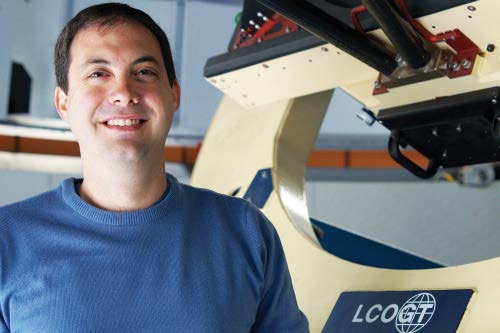 Iair Arcavi. Photo by Sonia Fernandez.
Iair Arcavi. Photo by Sonia Fernandez.
The mass of supermassive black holes is almost beyond imagining. They can be millions, even billions of times the mass of our sun. While scientists aren’t clear about how such entities could exist, these behemoths apparently inhabit the center of almost all galaxies.
And Iair Arcavi wants to learn more.
Arcavi, a joint postdoctoral scholar at UC Santa Barbara’s Kavli Institute for Theoretical Physics (KITP) and the Las Cumbres Observational Global Telescope (LCOGT), will be able to do just that as the recipient of the 2015 Harvey L. Karp Discovery Award. Funded through a $48,000 gift from international business leader and entrepreneur Harvey Karp, the award is intended to support the innovative research of exceptional early career postdocs in UCSB’s Division of Mathematical, Life and Physical Sciences.
“I was really excited — and surprised — to receive the Karp award,” Arcavi said. “After all, black holes are so esoteric. But I’m happy that curiosity-driven research like mine is being recognized and supported.”
In order to form a more complete picture of supermassive black holes, Arcavi will use the award to advance his latest research project, “Seeing the Invisible: A New Tool for Discovering and Studying Supermassive Black Holes.”
Lars Bildsten, director of KITP, nominated Arcavi for the award. “I have given Iair a large amount of freedom to define his own projects and explore, which he has done with vigor,” Bildsten said. “His publication record speaks to his broad involvement in many distinct activities, and this project is in the prime field where Iair intends to make a distinctive mark.”
To contribute to the science of supermassive black holes, Arcavi and colleagues at LCOGT will look for tidal disruption events in very specific types of galaxies. Tidal disruption occurs when a star orbiting a massive black hole makes a close approach and is pulled apart by the black hole tidal forces.
The idea of tidal disruption events originated in the 1970s, but it wasn’t until 2012 that scientists reported witnessing one of these rare events. In 2014, three more were described in a paper led by Arcavi using data from the Palomar Transient Factory, a Caltech-led transient survey. Arcavi also published new data on a fourth event found by an Ohio State University-led survey called ASAS-SN and linked two other events in the literature to this class of tidal disruption events.
All of these events share common properties. In fact, six out of the seven occurred in a very rare type of galaxy called E+A. The E stands for elliptical and the A for A-type stars, which are overabundant in E+A galaxies.
“It’s been very exciting and we want to find more because seven is not enough,” Arcavi said. “We still don’t understand the. events themselves and if we want to use them to deduce the mass of a black hole, we first have to understand what’s going on when a star gets disrupted.”
The project will use the LCOGT’s network to track 100 of the most easily observable E+A galaxies, visiting each of them once a month for a year. Images will be compared to determine whether new points of light have occurred. These could represent tidal disruption events.
“No one has ever specifically monitored E+A galaxies in any kind of transient survey so we don’t know what we’ll find,” Arcavi said. “The worst case is we detect nothing in 100 galaxies. Then we can say the rate is not once per year, not even once per 10 years; it’s probably lower than once in 100 years. That would set some limits, but the optimistic scenario is that we witness stars being disrupted in these galaxies. We’re hopeful — but either way it should be interesting.”
“Iair Arcavi is a visionary, and I’m thrilled to see this acknowledged by the Karp Discovery Award,” said Andy Howell, leader of the supernova group at LCOGT, which includes Arcavi. “His work lets us see the universe in new ways, and the technology he will develop here will allow us to better understand stars being disrupted by black holes but will be useful for all kinds of research beyond that. He’s gambling for big results, but it is built on a safe bet that looking at the sky in a new way is always a winner.”
- Julie Cohen, UCSB Public Affairs & Communication
KITP Newsletter, Fall 2015
